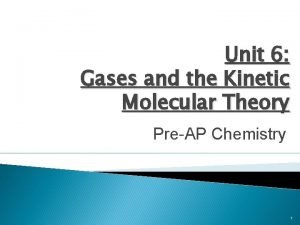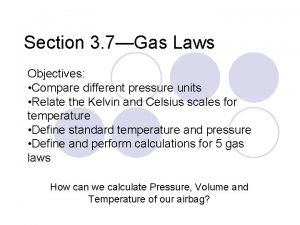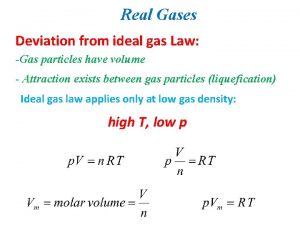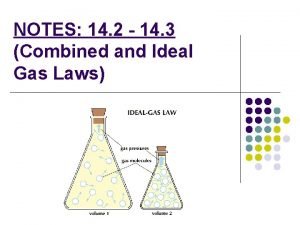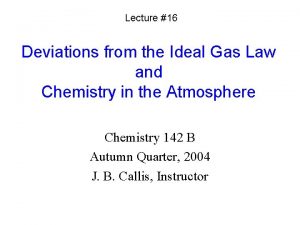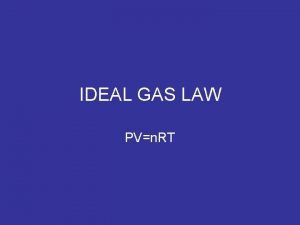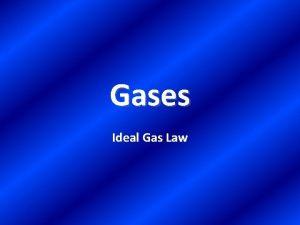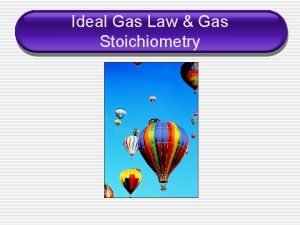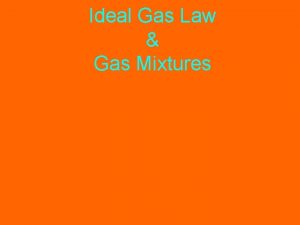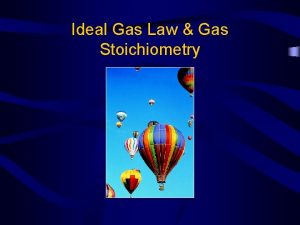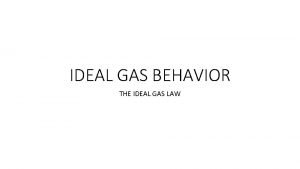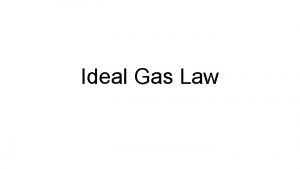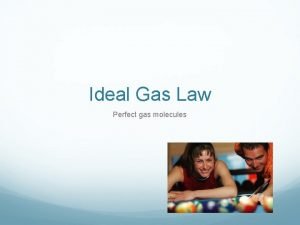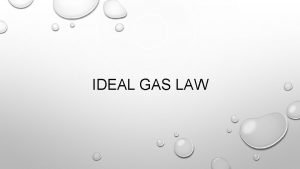The Ideal Gas Law PV n RT Ideal












- Slides: 12

The Ideal Gas Law PV = n. RT

Ideal Gases An “ideal” gas exhibits certain theoretical properties. Specifically, an ideal gas … • Obeys all of the gas laws under all conditions. • Does not condense into a liquid when cooled. • Shows perfectly straight lines when its V and T & P and T relationships are plotted on a graph. In reality, there are no gases that fit this definition perfectly. We assume that gases are ideal to simplify our calculations. We have done calculations using several gas laws (Boyle’s Law, Charles’s Law, Combined Gas Law). There is one more to know…

The Ideal Gas Law PV = n. RT P = Pressure (in k. Pa) V = Volume (in L) T = Temperature (in K) n = moles R = 8. 31 k. Pa • L K • mol R is constant. If we are given three of P, V, n, or T, we can solve for the unknown value. Recall, From Boyle’s Law: P 1 V 1 = P 2 V 2 or PV = constant From combined gas law: P 1 V 1/T 1 = P 2 V 2/T 2 or PV/T = constant

Developing the ideal gas law equation PV/T = constant. What is the constant? At STP: T= 273 K, P= 101. 3 k. Pa, V= 22. 4 L/mol Because V depends on mol, PV = constant we can change equation to: T • mol Mol is represented by n, PV = R constant by R: Tn Rearranging, we get: PV = n. RT At STP: (101. 3 k. Pa)(22. 4 L) = (1 mol)(R)(273 K) R = 8. 31 k. Pa • L K • mol Note: always use k. Pa, L, K, and mol in ideal gas law questions (so units cancel)

Sample problems How many moles of H 2 is in a 3. 1 L sample of H 2 measured at 300 k. Pa and 20°C? PV = n. RT P = 300 k. Pa, V = 3. 1 L, T = 293 K (300 k. Pa)(3. 1 L) = n (8. 31 k. Pa • L/K • mol)(293 K) (300 k. Pa)(3. 1 L) = n = 0. 38 mol (8. 31 k. Pa • L/K • mol)(293 K) How many grams of O 2 are in a 315 m. L container that has a pressure of 12 atm at 25°C? PV = n. RT P= 1215. 9 k. Pa, V= 0. 315 L, T= 298 K (1215. 9 k. Pa)(0. 315 L) = n = 0. 1547 mol (8. 31 k. Pa • L/K • mol)(298 K) 0. 1547 mol x 32 g/mol = 4. 95 g

Ideal Gas Law Questions 1. How many moles of CO 2(g) is in a 5. 6 L sample of CO 2 measured at STP? 2. a) Calculate the volume of 4. 50 mol of SO 2(g) measured at STP. b) What volume would this occupy at 25°C and 150 k. Pa? (solve this 2 ways) 3. How many grams of Cl 2(g) can be stored in a 10. 0 L container at 1000 k. Pa and 30°C? 4. At 150°C and 100 k. Pa, 1. 00 L of a compound has a mass of 2. 506 g. Calculate its molar mass. 5. 98 m. L of an unknown gas weighs 0. 087 g at SATP. Calculate the molar mass of the gas. Can you determine the identity of this unknown gas?

1. Moles of CO 2 is in a 5. 6 L at STP? P=101. 325 k. Pa, V=5. 6 L, T=273 K PV = n. RT (101. 3 k. Pa)(5. 6 L) = n (8. 31 k. Pa • L/K • mol)(273 K) (101. 325 k. Pa)(5. 6 L) (8. 31 k. Pa • L/K • mol)(273 K) = n = 0. 25 mol 2. a) Volume of 4. 50 mol of SO 2 at STP. P= 101. 3 k. Pa, n= 4. 50 mol, T= 273 K PV=n. RT (101. 3 k. Pa)(V)=(4. 5 mol)(8. 31 k. Pa • L/K • mol)(273 K) (4. 50 mol)(8. 31 k. Pa • L/K • mol)(273 K) V= = 100. 8 L (101. 3 k. Pa)

2. b) Volume at 25°C and 150 k. Pa (two ways)? Given: P = 150 k. Pa, n = 4. 50 mol, T = 298 K (4. 50 mol)(8. 31 k. Pa • L/K • mol)(298 K) V= = 74. 3 L (150 k. Pa) From a): P = 101. 3 k. Pa, V = 100. 8 L, T = 273 K Now P = 150 k. Pa, V = ? , T = 298 K P 1 V 1 P 2 V 2 = T 1 T 2 (101. 3 k. Pa)(100 L) (150 k. Pa)(V 2) = (273 K) (298 K) (101. 3 k. Pa)(100. 8 L)(298 K) = 74. 3 L (V 2) = (273 K)(150 k. Pa)

3. How many grams of Cl 2(g) can be stored in a 10. 0 L container at 1000 k. Pa and 30°C? PV = n. RT P= 1000 k. Pa, V= 10. 0 L, T= 303 K (1000 k. Pa)(10. 0 L) = n = 3. 97 mol (8. 31 k. Pa • L/K • mol)(303 K) 3. 97 mol x 70. 9 g/mol = 282 g 4. At 150°C and 100 k. Pa, 1. 00 L of a compound has a mass of 2. 506 g. Calculate molar mass. PV = n. RT P= 100 k. Pa, V= 1. 00 L, T= 423 K (100 k. Pa)(1. 00 L) = n = 0. 02845 mol (8. 31 k. Pa • L/K • mol)(423 K) g/mol = 2. 506 g / 0. 02845 mol = 88. 1 g/mol

5. 98 m. L of an unknown gas weighs 0. 081 g at SATP. Calculate the molar mass. PV = n. RT P= 100 k. Pa, V= 0. 098 L, T= 298 K (100 k. Pa)(0. 098 L) = n = 0. 00396 mol (8. 31 k. Pa • L/K • mol)(298 K) g/mol = 0. 081 g / 0. 00396 mol = 20. 47 g/mol It’s probably neon (neon has a molar mass of 20. 18 g/mol)

Determining the molar mass of butane Using a butane lighter, balance, and graduated cylinder determine the molar mass of butane. • Determine the mass of butane used by weighing the lighter before and after use. • The biggest source of error is the mass of H 2 O remaining on the lighter. As a precaution, dunk the lighter & dry well before measuring initial mass. After use, dry well before taking final mass. (Be careful not to lose mass when drying). • When you collect the gas, ensure no gas escapes & that the volume is 90 – 100 m. L. • Place used butane directly into fume hood. • Submit values for mass, volume, & g/mol.

Molar Mass of Butane: Data & Calculations Atmospheric pressure: Temperature: For more lessons, visit www. chalkbored. com
 Derive ideal gas equation
Derive ideal gas equation Imaginary gas
Imaginary gas Differences between ideal gas and real gas
Differences between ideal gas and real gas Sutherland's law
Sutherland's law Difference between ideal gas and real gas
Difference between ideal gas and real gas Unit of pressure
Unit of pressure Ideal gas law
Ideal gas law Avogadro's law units
Avogadro's law units Which equation agrees with the ideal gas law?
Which equation agrees with the ideal gas law? Deviations from ideal gas law
Deviations from ideal gas law Combined gas law
Combined gas law Deviations from the ideal gas law
Deviations from the ideal gas law Ideal gas law graphs
Ideal gas law graphs





